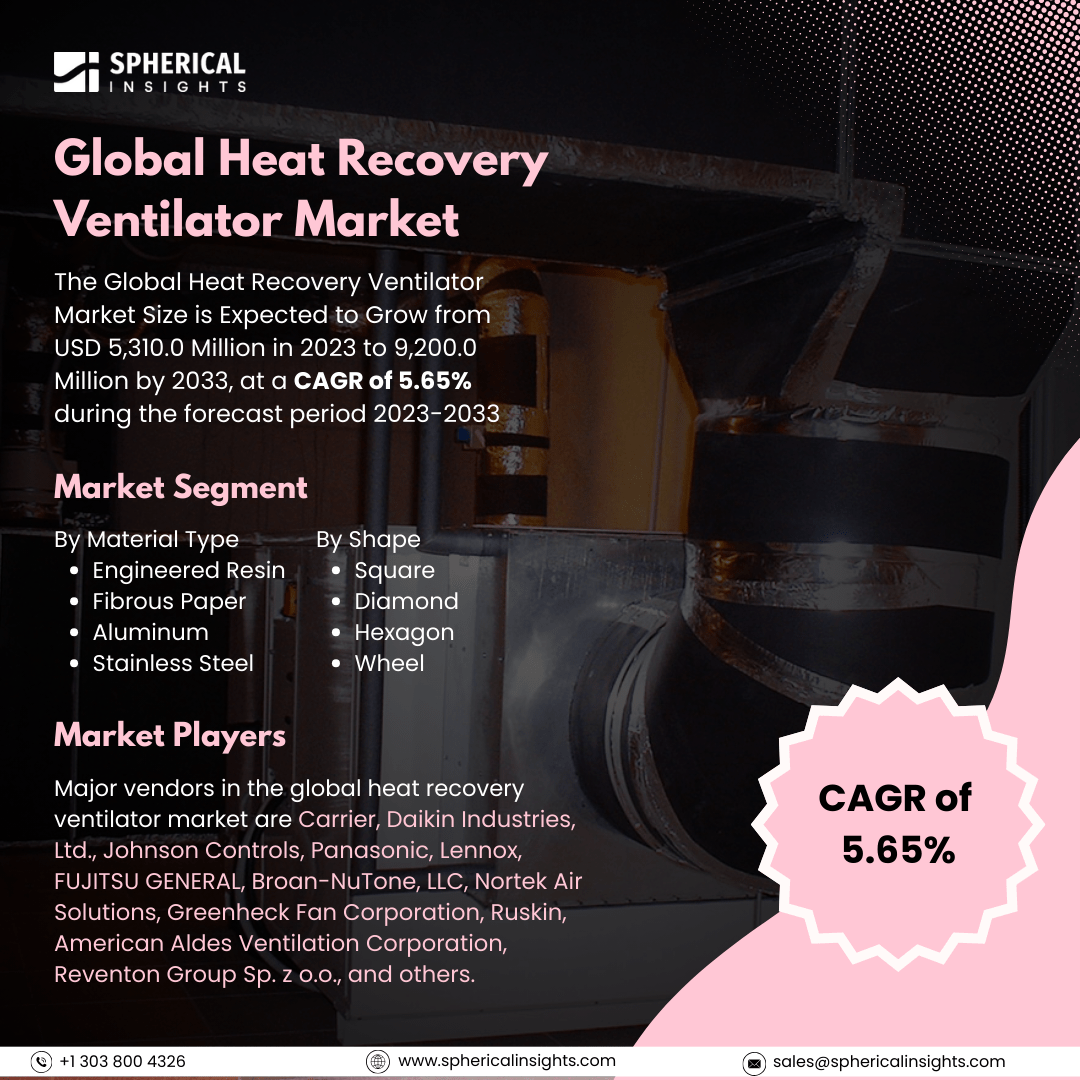Global Heat Recovery Ventilator Market Size to Exceed 9,200.0 Million by 2033
According to a research report published by Spherical Insights & Consulting, The Global Heat Recovery Ventilator Market Size is Expected to Grow from USD 5,310.0 Million in 2023 to 9,200.0 Million by 2033, at a CAGR of 5.65% during the forecast period 2023-2033.
Browse 210 market data Tables and 45 Figures spread through 190 Pages and in-depth TOC on the Global Heat Recovery Ventilator Market Size, Share, and COVID-19 Impact Analysis, By Material Type (Engineered Resin, Fibrous Paper, Aluminum, and Stainless Steel), By Shape (Square, Diamond, Hexagon, and Wheel), and By Region (North America, Europe, Asia Pacific, Latin America, Middle East, and Africa), Analysis and Forecast 2023 – 2033
The heat recovery ventilator market is the worldwide industry that deals with the design, production, and sale of HRV systems, which improve indoor air quality and energy efficiency by transferring stale indoor air with fresh outdoor air while recovering heat from the exhaust air. Moreover, the heat recovery ventilator market is propelled by growing energy efficiency regulations, expanding indoor air quality awareness, and rising demand for green HVAC solutions. Urbanization, smart home penetration, and heat recovery technology advancements are some of the factors that enhance market growth. Government incentives for energy-efficient buildings and enhanced ventilation standards also drive adoption globally. However, the heat recovery ventilator (HRV) market is hindered by factors like high upfront costs, complicated installation, maintenance issues, and low awareness in developing countries, which may discourage mass adoption even in the face of long-term energy savings advantages.
The aluminum segment accounted for the largest share of the global heat recovery ventilator market in 2023 and is anticipated to grow at a significant CAGR during the forecast period.
Based on the material type, the global heat recovery ventilator market is divided into engineered resin, fibrous paper, aluminum, and stainless steel. Among these, the aluminum segment accounted for the largest share of the global heat recovery ventilator market in 2023 and is anticipated to grow at a significant CAGR during the forecast period. This is because of its high thermal conductivity, long lifespan, and corrosion resistance. Aluminum heat exchangers offer greater energy efficiency and performance, becoming the most sought-after product for residential, commercial, and industrial HVAC uses because of their cost savings and reliability.
The wheel segment accounted for a substantial share of the global heat recovery ventilator market in 2023 and is anticipated to grow at a rapid pace during the projected period.
On the basis of the shape, the global heat recovery ventilator market is divided into square, diamond, hexagon, and wheel. Among these, the wheel segment accounted for a substantial share of the global heat recovery ventilator market in 2023 and is anticipated to grow at a rapid pace during the projected period. This is motivated by their high heat and moisture transfer efficiency, low costs, and ubiquity in use in commercial as well as industrial processes. The wheel-type heat exchanger offers constant air flow, greater ventilation, as well as enhanced energy recovery and is thus preferred.
North America is projected to hold the largest share of the global heat recovery ventilator market over the projected period.
North America is projected to hold the largest share of the global heat recovery ventilator market over the projected period. This is motivated by their high heat and moisture transfer efficiency, low costs, and ubiquity in use in commercial as well as industrial processes. The wheel-type heat exchanger offers constant air flow, greater ventilation, as well as enhanced energy recovery and is thus preferred.
Europe is expected to grow at the fastest CAGR of the global heat recovery ventilator market during the projected period. This is driven by stringent building energy efficiency standards, increasing demand for green HVAC systems, and rising indoor air quality awareness. Promotional efforts from governments towards green buildings and smart ventilation systems are also driving the market growth across the region.
Company Profiling
Major vendors in the global heat recovery ventilator market are Carrier, Daikin Industries, Ltd., Johnson Controls, Panasonic, Lennox, FUJITSU GENERAL, Broan-NuTone, LLC, Nortek Air Solutions, Greenheck Fan Corporation, Ruskin, American Aldes Ventilation Corporation, Reventon Group Sp. z o.o., and others.
Key Target Audience
- Market Players
- Investors
- End-users
- Government Authorities
- Consulting and Research Firm
- Venture capitalists
- Value-Added Resellers (VARs)
Recent Development
- In January 2025, Greenheck introduced the ERVi, a small energy recovery ventilator for basements and mechanical rooms. The unit fits through a 30-inch doorway and can be ceiling-mounted for retrofit applications. It comes in two models, the ERVi-10 with 375-1,500 cfm at 18 inches high and the ERVi-20 with 750-2,500 cfm at 23 inches high.
Market Segment
This study forecasts revenue at global, regional, and country levels from 2023 to 2033. Spherical Insights has segmented the global heat recovery ventilator market based on the below-mentioned segments:
Global Heat Recovery Ventilator Market, By Material Type
- Engineered Resin
- Fibrous Paper
- Aluminum
- Stainless Steel
Global Heat Recovery Ventilator Market, By Shape
- Square
- Diamond
- Hexagon
- Wheel
Global Heat Recovery Ventilator Market, By Regional
- North America
- Europe
- Germany
- UK
- France
- Italy
- Spain
- Russia
- Rest of Europe
- Asia Pacific
- China
- Japan
- India
- South Korea
- Australia
- Rest of Asia Pacific
- South America
- Brazil
- Argentina
- Rest of South America
- Middle East & Africa
- UAE
- Saudi Arabia
- Qatar
- South Africa
- Rest of the Middle East & Africa



